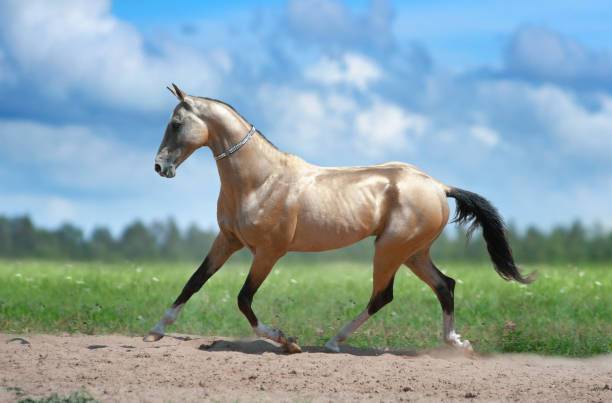When visitors first lay eyes on an Akhal Teke Horse, they’re often mesmerized by its metallic sheen and graceful movements.
This ancient breed, hailing from Turkmenistan, is more than just a pretty face t’s a symbol of endurance, intelligence, and rich cultural heritage.
Known as the “Golden Horse,” the Akhal Teke is one of the rarest miniature horse breeds in the world, with a lineage that spans over 3,000 years.
Whether you’re a seasoned equestrian or a newcomer to the world of horses, the Akhal Teke’s story is sure to captivate you.
The Fascinating History of the Akhal Teke Horse

The Akhal Teke Horse has a rich history that dates back to the ancient Turkmen tribes. These tribes bred the Akhal Teke for endurance and speed, qualities that were essential for survival in the harsh desert climate.
The breed’s origins are closely linked to the Turkoman horse, and some historians believe the two may even be the same.
Over the centuries, the Akhal Teke has been cherished not only for its physical abilities but also for its deep loyalty to its owners.
Characteristics and Unique Traits of the Akhal Teke Horse
The Akhal Teke Horse is easily recognizable thanks to its slender build, long neck, and shiny coat, which often has a metallic sheen.
This breed typically stands between 14 to 16 hands high and weighs around 950 to 1,100 pounds.
Akhal Teke horses come in a variety of colors, including bay, black, chestnut, and the distinctive golden dun. Their fine skin and thin coat make them particularly suited to the desert environment, where they originally thrived.
| Trait | Details |
| Height | 14 to 16 hands (56 to 64 inches) |
| Weight | 950 to 1,100 pounds |
| Coat Colors | Bay, black, chestnut, golden dun |
| Unique Features | Metallic sheen, almond-shaped eyes |
Breeding and Traditions Surrounding the Akhal Teke Horse

Breeding the Akhal Teke Horse is considered an art in Turkmenistan. The breed’s bloodlines have been carefully preserved for thousands of years, and many customs and traditions are associated with it.
For instance, during weddings, the groom often rides a decorated Akhal Teke horse to fetch the bride. These horses are not just a mode of transportation—they’re a symbol of status and heritage.
The breeding practices have been passed down through generations, ensuring that the Akhal Teke remains one of the most genetically pure breeds in the world.
Famous Riders of the Akhal Teke Horse
It has been favored by many notable riders throughout history. Here are three famous riders known for their association with this majestic breed:
- Sergei Filatov – A Soviet dressage rider who won the gold medal at the 1960 Summer Olympics in Rome riding an Akhal Teke horse named Absent.
- Ivan Kalita – Another Soviet rider who competed with Akhal Teke horses and won multiple medals, including team gold in the 1968 Mexico City Olympics.
- Geldy Kyarizov – A Turkmen horse breeder and advocate who has been instrumental in preserving the Akhal Teke breed.
The Modern-Day Use of the Akhal Teke Horse

Today, it is used in a variety of equestrian sports, including dressage, show jumping, and endurance riding.
Their athleticism, intelligence, and loyalty make them excellent companions for riders who appreciate a horse that is both responsive and resilient.
However, their rarity means that owning an Akhal Teke is often seen as a symbol of prestige.
Health and Care of the Akhal Teke Horse

Like all purebred horses, the Akhal Teke Horse is prone to certain genetic diseases due to its limited genetic diversity.
Some of the common health issues include cervical vertebral malformation (CVM), also known as wobbler syndrome, and degenerative suspensory ligament desmitis (DSLD).
Regular veterinary check-ups, a balanced diet, and proper grooming are essential to maintaining the health and well-being of an Akhal Teke.
| Health Issue | Description |
| Cervical Vertebral Malformation (CVM) | Neurological disorder causing an uncoordinated gait |
| Degenerative Suspensory Ligament Desmitis (DSLD) | Condition affecting the horse’s ligaments, leading to pain and lameness |
| Naked Foal Syndrome | A rare genetic condition where foals are born without hair |
Bar Graph of Akhal Teke Horse Population Worldwide
Here’s a visual representation of the distribution of the Akhal Teke Horse population across different regions:
Please note: The actual graph should include data for regions such as Turkmenistan, Russia, Central Asia, the USA, and Europe.
Wrapping Up
The Akhal Teke Horse is more than just a rare breed—it’s a living piece of history that continues to captivate horse lovers around the world.
From its ancient origins to its modern-day applications in sports and cultural traditions, the Akhal Teke is a breed like no other.
Whether you’re drawn to its stunning appearance, rich history, or unique traits, it is truly a treasure in the equine world.

